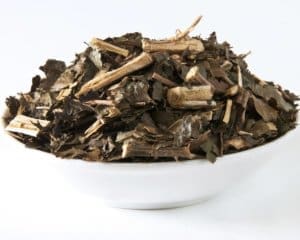In the dense tropical forests of Brazil, the Cordia salicifolia tree shares its brilliant, red berries with the world. For generations, the people of Brazil have sought these beautiful berries as a support for a variety of conditions including encouraging weight loss, circulation, and better overall wellness. Today, this botanical is commonly referred to as Chá de Bugre.
Where is it found?
 Cordia salicifolia, or Chá de Bugre, is a small, evergreen tree that can grow to heights of 8 to 12 meters with a trunk diameter of 30 to 40 centimeters1. The trees are found in sunny, moist forests in Brazil, Paraguay, and Argentina. Belonging to the larger family “Boraginaceae,” common names for the plant include Porangaba, Chá de Bugre, and Café do Mato.
Cordia salicifolia, or Chá de Bugre, is a small, evergreen tree that can grow to heights of 8 to 12 meters with a trunk diameter of 30 to 40 centimeters1. The trees are found in sunny, moist forests in Brazil, Paraguay, and Argentina. Belonging to the larger family “Boraginaceae,” common names for the plant include Porangaba, Chá de Bugre, and Café do Mato.
How is Chá de Bugre used?
It’s those berries that give it the nickname, Café do Mato, or “coffee of the woods.” The bright, red berries have the same consistency and characteristics of traditional coffee beans and contain natural caffeine. Brazilians roast the berries and brew a tea that they enjoy as a substitute for coffee2.
While it has experienced extreme popularity in Brazil for its health properties, there has been little scientific work completed to analyze the biological active compounds of the plant. We do know, however, that it contains caffeine, potassium, allantoin, and allantonic acid3.
In Brazil, it has been a long-time popular dietary supplement on the beaches of Rio and Copacabana to encourage a slim appearance. People who drink it as a tea often report “feeling full” more quickly resulting in eating of smaller meals. To be most effective locals recommend consuming it about 30 minutes prior to eating4.
 Chá de Bugre is popular as a cold tea sold along the beaches of Ipanema and Copacabana and has been used for centuries in Brazil to promote general wellness. Two biological components, allantoin and allantoic acid, are frequently used topically to promoting normal skin healing. This is likely because allantoin and allantoic acid have both been shown to promote faster skin cell division5. Additionally, people have steeped or soaked leaves, fruit, or bark to create tinctures, extracts, and teas to support wellness6.
Chá de Bugre is popular as a cold tea sold along the beaches of Ipanema and Copacabana and has been used for centuries in Brazil to promote general wellness. Two biological components, allantoin and allantoic acid, are frequently used topically to promoting normal skin healing. This is likely because allantoin and allantoic acid have both been shown to promote faster skin cell division5. Additionally, people have steeped or soaked leaves, fruit, or bark to create tinctures, extracts, and teas to support wellness6.
At Herbs-America, our Chá de Bugre (Cordia salicifolia) is made in the traditional way collected in a pristine area of Brazil. It’s one of our most popular and tasty herbs. CLICK HERE to add this dietary supplement to your daily regimen. A freshly brewed cup taken once or twice a day is all you need to experience the benefits of this classic Amazon tonic. *
Taylor, Leslie. The Healing Power of the Rainforest Herbs, 2005, Text reprinted at: http://www.rain-tree.com/chadebugre.htm. ↩
Chá de Bugre, WebMD, https://www.webmd.com/vitamins/ai/ingredientmono-1124/cha-de-bugre ↩
Taylor, Leslie. The Healing Power of the Rainforest Herbs, 2005, Text reprinted at: http://www.rain-tree.com/chadebugre.htm. ↩
Fern, Ken. Useful Tropical Plants Database, 2019, http://tropical.theferns.info/viewtropical.php?id=Cordia+ecalyculata ↩
Fern, Ken. Useful Tropical Plants Database, 2019, http://tropical.theferns.info/viewtropical.php?id=Cordia+ecalyculata ↩
Chá de Bugre, Australian School of Meditation and Yoga, https://asmy.org.au/lifestyle/cha-de-bugre/ ↩

Reader Interactions